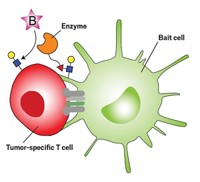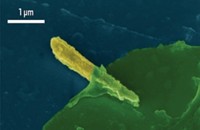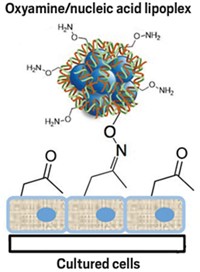Advertisement
Grab your lab coat. Let's get started
Welcome!
Welcome!
Create an account below to get 6 C&EN articles per month, receive newsletters and more - all free.
It seems this is your first time logging in online. Please enter the following information to continue.
As an ACS member you automatically get access to this site. All we need is few more details to create your reading experience.
Not you? Sign in with a different account.
Not you? Sign in with a different account.
ERROR 1
ERROR 1
ERROR 2
ERROR 2
ERROR 2
ERROR 2
ERROR 2
Password and Confirm password must match.
If you have an ACS member number, please enter it here so we can link this account to your membership. (optional)
ERROR 2
ACS values your privacy. By submitting your information, you are gaining access to C&EN and subscribing to our weekly newsletter. We use the information you provide to make your reading experience better, and we will never sell your data to third party members.
Biotechnology
Click chemistry offers a way to turn cells into potential therapies
Modified glycans on cell surfaces let chemists add functionalized polymers to cells
by Leigh Krietsch Boerner, special to C&EN
July 3, 2019

Cell-based therapies are becoming more prevalent in medical practice. For example, chimeric antigen receptor T-cell (CAR-T) therapy works by removing a patient’s immune cells from their blood, genetically modifying them to express tumor-protein receptors, and then infusing the cells back into the patient. However, the process can be inefficient, costly, and time consuming. Now, researchers have demonstrated a simpler method of modifying cells: they synthesize a water-soluble polymer that can click right onto glycan molecules on the cell surface (Biomacromolecules 2019, DOI: 10.1021/acs.biomac.9b00478). It’s still far from clinical use, but the method could offer a promising alternative to CAR-T therapy and also be a way to attach drugs, imaging agents, and other therapies onto cells, the researchers say.
The advantage is that it’s a straightforward chemical method, says Matthew I. Gibson, a polymer chemist at the University of Warwick. His group used a process called glycan metabolic labeling, developed by Carolyn R. Bertozzi of Stanford University and coworkers. All mammalian cells are coated in a thick layer of glycan carbohydrate molecules. By simply feeding the cell a sugar that’s been modified to include a particular functional group, “that sugar will be metabolized by the cell, and some of that functionality is expressed on the cell surface,” Gibson says.
In this study, the group fed human lung carcinoma cells a sugar with an azide group, which is well known for doing click chemistry. “We can use the azide as a handle to reprogram the cell surface with a new functionality,” he says. As a proof of principle, the researchers mixed in a polymer, N-hydroxyethyl acrylamide, which reacted with the azides expressed on the surface of the cells, clicking on via a metal-free cycloaddition.
The group then used confocal microscopy and flow cytometry to see that the polymers expressed on the surface of the cells were not embedded in the cell membrane and that they stayed on the surface for a reasonable amount of time. “If the label falls off, that’s not much use,” Gibson says. “This method is relatively robust.” They also ran a viability assay, because sometimes attaching certain molecules can kill cells. “We don’t lose any of them,” he says.
The authors go after a major target of programmable cells—glycans, says Craig J. Hawker, a polymer chemist at the University of California, Santa Barbara, and their simple and straightforward approach is very attractive. “It will allow a wide range of researchers access to synthetically functionalized cell surfaces, greatly expanding this valuable and important field,” he says.
In the future, Gibson hopes to add some potentially therapeutic functional groups to the polymers with his new method.





Join the conversation
Contact the reporter
Submit a Letter to the Editor for publication
Engage with us on Twitter